 Photo by John & Karen Hillingsworth, courtesy of US Fish & Wildlife Service
Photo by John & Karen Hillingsworth, courtesy of US Fish & Wildlife ServiceOnce you're familiar with organisms and ecosystems around your home, a whole new world opens itself up to you. That world is composed of the plants and animals beyond your everday environment.
Once you've identified and begun learning about Nature in your own backyard, you'll be set to travel. Maybe travel only to the next block, or the park, or possibly even to the opposite side of the Earth. Wherever you go, your studies of what you've discovered in your own backyard will be the key to a higher level of knowing about and experiencing the rest of the natural world.
 A local park may offer a whole new world to get to know
A local park may offer a whole new world to get to knowIf your neighborhood has no wetlands, if you can get to a pond, swamp, marsh or beach that may be just a few minutes away, many species will be different from what you've seen in your backyard. If there's a nearby hill with rocky cliffs, simply by climbing the hill you'll discover new niches with new plants and animals, and maybe even discover the pleasure of understanding why that hill is there in the first place, what kind of rock it's made of, how old the rock is, and what the Earth was like when that rock was formed.
Some of us, especially if we live in a mountainous area, can enter a whole new biome with very many new-to-us species of many kinds. Biomes are very large communities of plants an animals, such as North America's Temperate Deciduous Forest, the Northern Coniferous Forest, and the Temperate Grassland or Prairie Province. Below you see the world's major biomes:
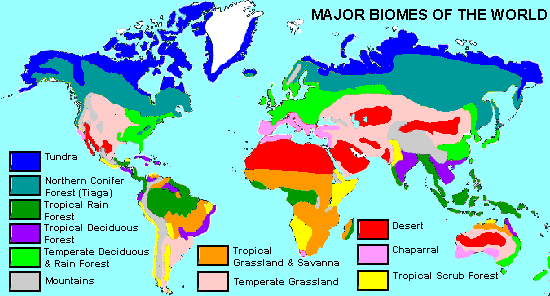
Smaller biomes include those such as North America's Pacific Rain Forest, and Pinyon-Juniper Biomes. All biomes are ecosystems, but ecosystems can be larger or smaller than biomes.
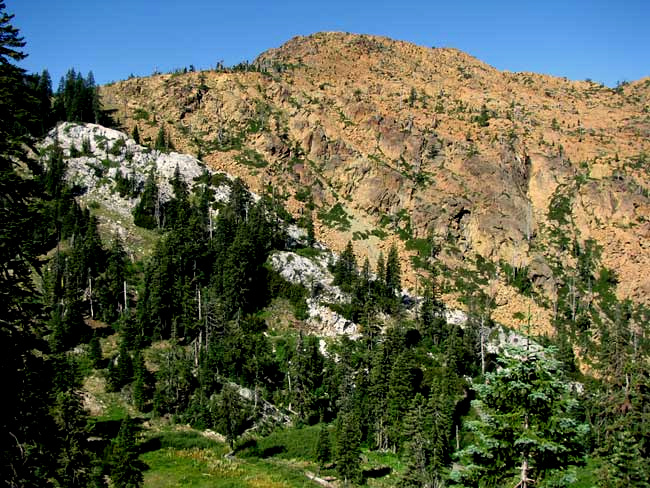
In the mountains, changing elevation a few hundred feet is equivalent, biologically speaking, to traveling north or south overland for hundreds of miles. In the East, to visit taiga, which is a swampy, coniferous forest in very cold locations, one must travel deep into Canada. In the west, climbing some of the highest mountains can take you into treeless tundra, similar to what's in the arctic.
Two main things should be realized about the above map:
- In many but not all cases the boundaries between the zones are indistinct -- they gradually intergrade with one another
- Every zone can be subdivided, and that subdivision can be subdivided, and that subdivision can be subdivided, etc.
Notice how many "forest regions" the map below shows just for the Eastern US, even though in the above map the same area clearly shows only two biomes. Moreover, each of the map's forest regions can be divided into many smaller zones. For example, in some places in the "Western Mesophytic" forest type (western part of eastern North America...), there are pure oak forests, in others pure beech and maple, and in some places, at least before the Europeans arrived, there were even natural grasslands!
 Oak-Pine
Oak-Pine Grassland
Grassland Beech-Maple
Beech-Maple Oak-Hickory
Oak-Hickory Subtropical
Subtropical Maple-Basswood
Maple-Basswood Mixed Mesophytic
Mixed Mesophytic Western Mesophytic
Western Mesophytic Boreal/ Spruce-Fir
Boreal/ Spruce-Fir SE Evergreen
SE Evergreen Hemlock-White Pine-Northern Hardwoods
Hemlock-White Pine-Northern Hardwoods Oak-Chestnut (Chestnuts killed by blight)
Oak-Chestnut (Chestnuts killed by blight)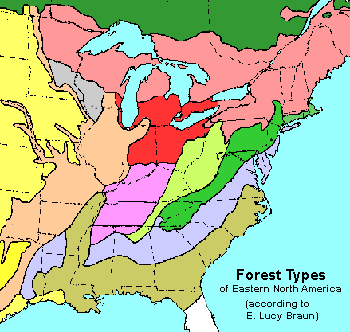
One good Internet site for exploring vegetation maps is the University of California Berkeley Library's Checklist of Online Vegetation and Plant Distribution Maps.
Larger than biomes are the earth's biogeographic regions, which more or less coincide with the planet's continents.Below is a map based on animals, so it is a "zoogeographic" map. A map showing the world's "phytogeographic" regions, based on plants, might be very similar but not identical.
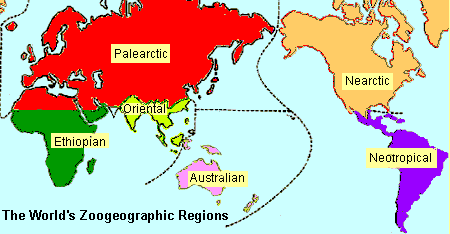
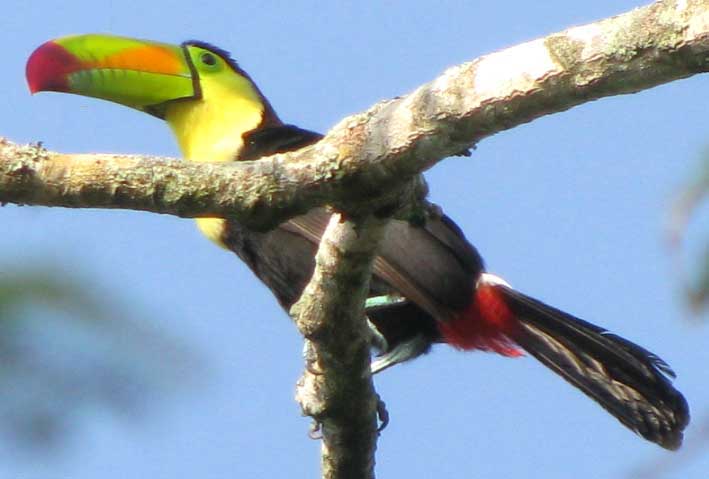
To travel into a new biogeographic region is to take a quantum leap into a world of new-to-you species and ecosystems. For North Americans, the closest "other biogeographic region," the Neotropical region, occurs in Mexico and the Caribbean. As an example of something spectacular you'd never see in the wild in North America, there's southern Mexico's Keel-billed Toucan, Ramphastos sulfuratus, shown in the picture.
Here's the thing: Seeing and experiencing the organisms and ecosystems of other biomes and other biogeographic regions won't mean nearly as much to you if you aren't already sensitized to and at least somewhat knowledgeable of the natures of wild things. And you can become sensitized to organisms and ecosystems, and start acquiring your knowledge about them, in your own backyard.
Therefore:
One goal of the backyard naturalist is to learn enough about local nature so that when you go naturalizing in other places, what you see there will just blow you away!
The National Audubon Society produces field guides profiling the general natural history of various regions of the US.
